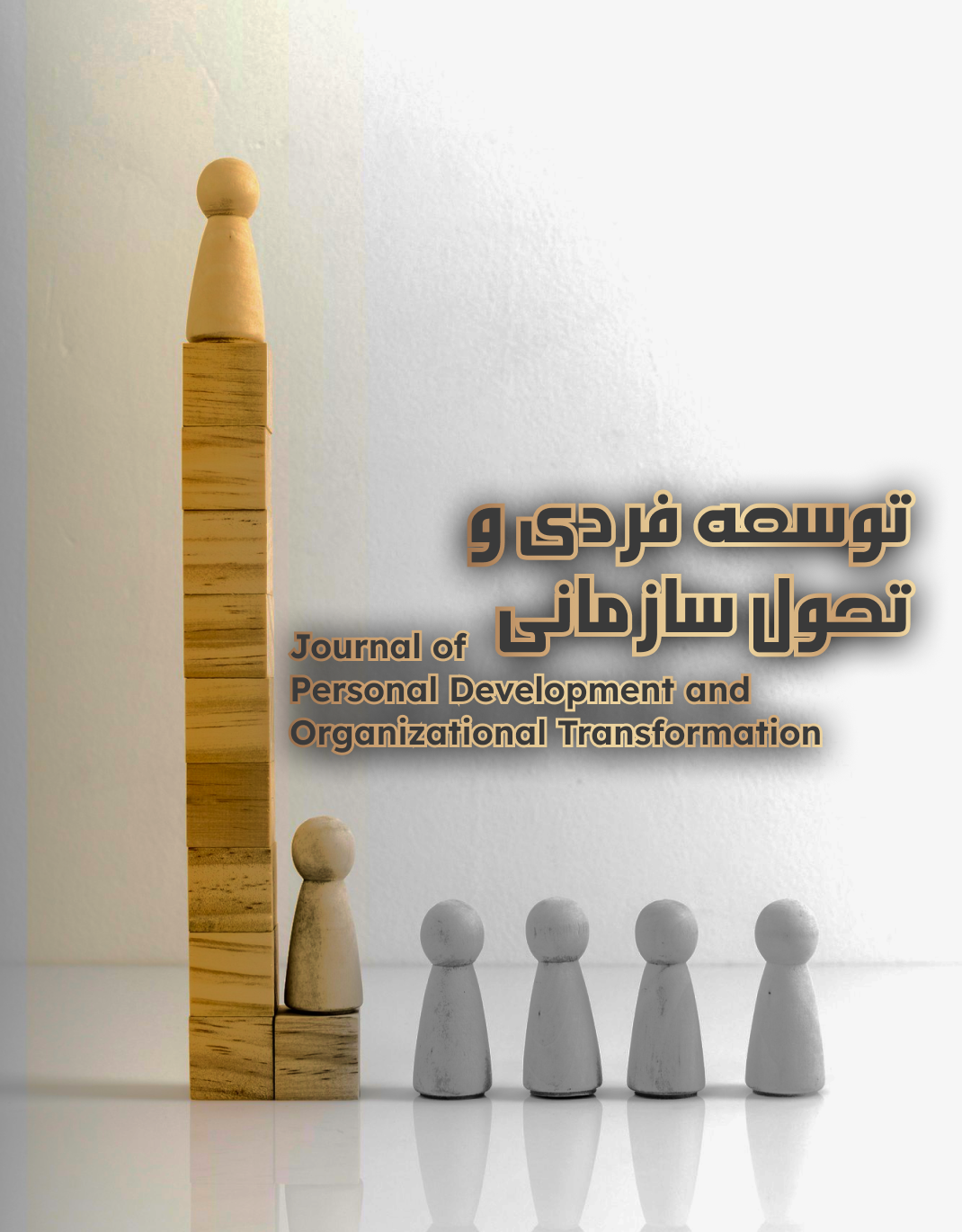مدلسازی نیازهای کاربران بانکی در بانکداری هوشمند مبتنی بر ارزش آفرینی
کلمات کلیدی:
نیازهای کاربران, بانکداری هوشمند, ارزش آفرینیچکیده
هدف از پژوهش حاضر، مدلسازی نیازهای کاربران بانکی در بانکداری هوشمند مبتنی بر ارزش آفرینی بـود. روش پژوهش، کیفی و مبتنی بر رویکرد تحلیل مضمون است. جامعه آماری این پـژوهش شـامل مشتریان ویژه بانک (مشتریانی با بالاترین سپرده و بیشترین تعامل با بانکداری هوشمند) و اساتید بازاریابی بودند که نمونـه گیری بـا اسـتفاده از روش هدفمند مبتنی بر رویکرد نظری صورت گرفت. جمعآوری اطلاعات تا اشباع نظری دادهها ادامه یافت و تعداد 14 مصاحبه فردی نیمه ساختاریافته انجام گرفت. کدهای کلیدی پس از مطالعه و استخراج با استفاده از رویکرد تحلیل مضمون برون و کلارک (2006) به صورت دستی مورد تحلیل قرار گرفتند. اعتبار نتایج پژوهش با استفاده از معیارهای گوبا و لینكولن (1985) مورد سنجش و تأیید قرار گرفت. براساس گزارش نهایی در مجموع 129 مضمون پایه از مجموع 14 مصاحبه ایجاد شد. سپس به دلیل کثرت مضامین پایه، تمامی مضامین مشابه بر پایۀ قرابت مفهومی و معنایی در گروه خاص خود قرار گرفتند و به 41 مضمون سازنده تقلیل یافتند. در نهایت بر اساس مضامین سازنده، 10 مضمون فراگیر دسترسی به خدمات دیجیتال؛ احراز هویت دیجیتال؛ امنیت دادههای بانکی؛ اعتماد به خدمات دیجیتال؛ مشاوره مالی هوشمند؛ گارانتی خدمات؛ انطباق با سبک زندگی دیجیتال؛ خدمات چندکاناله؛ بانکداری تطبیقپذیر با آینده مشتری؛ و تجربه نوآورانه بانکی ایجاد شد. با توجه به یافتههای پژوهش میتوان بیان کرد مدیران بانکی میتوانند با تمرکز بـر نیازهای شناسایی شده برای مشتریان خود در بانکداری هوشمند خلق ارزش کنند.
دانلودها
مراجع
Alalwan, A. A., Dwivedi, Y. K., & Rana, N. P. (2017). Factors influencing adoption of mobile banking by Jordanian bank customers: Extending UTAUT2 with trust. International Journal of Information Management, 37(3), 99-110. https://doi.org/10.1016/j.ijinfomgt.2017.01.002
Arner, D., Buckley, R., Zetzsche, D., & Sergeev, A. (2022). Digital finance, financial inclusion, and sustainable development: building better financial systems. https://www.researchgate.net/profile/Muhammad-Ayub-Mehar/publication/374536242_adbi_fintech-and-covid-19-web/links/652289423ab6cb4ec6c724c6/adbi-fintech-and-covid-19-web.pdf#page=193
Ayinaddis, S. G., Taye, B. A., & Yirsaw, B. G. (2023). Examining the effect of electronic banking service quality on customer satisfaction and loyalty: an implication for technological innovation. Journal of Innovation and Entrepreneurship, 12(1), 22. https://doi.org/10.1186/s13731-023-00287-y
Beshir, E. S., & Zelalem, B. A. (2020). The effect of e-banking service quality on customer's satisfaction and loyalty. The Strategic Journal of Business & Change Management, 7(3), 818-832. https://doi.org/10.61426/sjbcm.v7i3.1694
Chauhan, S., Akhtar, A., & Gupta, A. (2022). Customer experience in digital banking: a review and future research directions. International Journal of Quality and Service Sciences, 14(2), 311-348. https://doi.org/10.1108/IJQSS-02-2021-0027
Chu, H., & Zhan, X. (2024). The Impact of Digital Banking Services on Customer Satisfaction. Frontiers in Business, Economics and Management, 15(3), 356-360. https://doi.org/10.54097/5qaf7d23
Dhruv, G., Roggeveen, A. L., & Nordfält, J. (2017). The future of retailing. Journal of Retailing, 93(1), 1-6. https://doi.org/10.1016/j.jretai.2016.12.008
Gentsch, P. (2018). AI in marketing, sales and service: How marketers without a data science degree can use AI, big data and bots. Springer. https://doi.org/10.1007/978-3-319-89957-2
Gimpel, H., Rau, D., & Röglinger, M. (2018). Understanding FinTech start-ups-a taxonomy of consumer-oriented service offerings. Electronic Markets, 28, 245-264. https://doi.org/10.1007/s12525-017-0275-0
Gunasekaran, A., Yusuf, Y. Y., Adeleye, E. O., & Papadopoulos, T. (2018). Agile manufacturing practices: the role of big data and business analytics with multiple case studies. International Journal of Production Research, 56(1-2), 385-397. https://doi.org/10.1080/00207543.2017.1395488
Huang, M. H., & Rust, R. T. (2018). Artificial intelligence in service. Journal of Service Research, 21(2), 155-172. https://doi.org/10.1177/1094670517752459
Huang, M. H., & Rust, R. T. (2021). A strategic framework for artificial intelligence in marketing. Journal of the Academy of Marketing Science, 49, 30-50. https://doi.org/10.1007/s11747-020-00749-9
Jaakkola, E., & Alexander, M. (2014). The role of customer engagement behavior in value co-creation: a service system perspective. Journal of Service Research, 17(3), 247-261. https://doi.org/10.1177/1094670514529187
Jaliseh, S., Jafari Nia, S., Khairandish, M., & Hassanpour, A. (2019). Designing a network resource management model in the network governance of the Ministry of Health, Treatment, and Medical Education. Public policy, 5(3), 113-139.
Kano, N. (1984). Attractive quality and must-be quality. Journal of the Japanese Society for Quality Control, 31(4), 147-156. https://cir.nii.ac.jp/crid/1572261550744179968
Kim, S. H., & Yang, Y. R. (2025). The Effect of Digital Quality on Customer Satisfaction and Brand Loyalty Under Environmental Uncertainty: Evidence from the Banking Industry. Sustainability, 17(8), 3500. https://doi.org/10.3390/su17083500
Kotler, P., & Keller, K. L. (2016). A framework for marketing management. Prentice Hall. https://www.keyano.ca/en/resourcesGeneral/academics/FALL18_MARK4465.pdf
Lam, J. W. (2016). Robo-advisors: A portfolio management perspective Senior thesis, Yale College]. https://economics.yale.edu/sites/default/files/2023-01/Jonathan_Lam_Senior%20Essay%20Revised.pdf
Lee, I., & Shin, Y. J. (2018). Fintech: Ecosystem, business models, investment decisions, and challenges. Business Horizons, 61(1), 35-46. https://doi.org/10.1016/j.bushor.2017.09.003
Lemon, K. N., & Verhoef, P. C. (2016). Understanding customer experience throughout the customer journey. Journal of Marketing, 80(6), 69-96. https://doi.org/10.1509/jm.15.0420
Lusch, R. F., & Vargo, S. L. (2018). An Overview of Service-Dominant Logic. https://doi.org/10.4135/9781526470355.n1
Ng, I. C., & Wakenshaw, S. Y. (2017). The Internet-of-Things: Review and research directions. International Journal of Research in Marketing, 34(1), 3-21. https://doi.org/10.1016/j.ijresmar.2016.11.003
Nguyen, B., Simkin, L., Canhoto, A. I., & Khoa, B. T. (2020). The dark side of digital personalization: An agenda for research and practice. Journal of Business Research, 116, 209-221.
Nussipova, G., Nordin, F., & Sörhammar, D. (2020). Value formation with immersive technologies: an activity perspective. Journal of Business & Industrial Marketing, 35(3), 483-494. https://doi.org/10.1108/JBIM-12-2018-0407
Pousttchi, K., & Dehnert, M. (2018). Exploring the digitalization impact on consumer decision-making in retail banking. Electronic Markets, 28, 265-286. https://doi.org/10.1007/s12525-017-0283-0
Sarreshteh Dari, M., Pourkiani, M., & Emami, F. (2019). Developing a strategic model for customer loyalty using a thematic analysis approach. Strategic Studies in Sports and Youth, 18(45), 20-21. https://www.sid.ir/paper/400504/fa
Sironi, P. (2016). FinTech innovation: from robo-advisors to goal based investing and gamification. John Wiley & Sons. https://doi.org/10.1002/9781119227205
Zeithaml, V. A., Bitner, M. J., & Gremler, D. D. (2018). Services marketing: Integrating customer focus across the firm. McGraw-Hill. https://www.google.com/url?sa=t&source=web&rct=j&opi=89978449&url=https://www.researchgate.net/publication/315715048_Services_Marketing_Integrating_Customer_Focus_Across_the_Firm&ved=2ahUKEwiwn7rru7COAxXlQvEDHe-hDy8QFnoECBsQAQ&usg=AOvVaw3rsvOimtzO8D7PPCMdldWQ
دانلود
چاپ شده
ارسال
بازنگری
پذیرش
شماره
نوع مقاله
مجوز
حق نشر 2025 Ali Abiry (Author); Mehdi Mahmodzadeh Vashan; Hossein Hakimpour, Hamid Rezaeifar (Author)

این پروژه تحت مجوز بین المللی Creative Commons Attribution-NonCommercial 4.0 می باشد.






